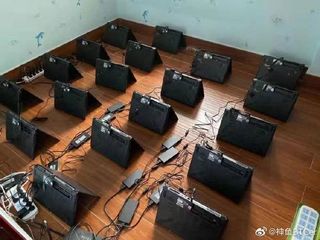
What do you do when you want to mine Ethereum and can't buy any of the best graphics cards? For some users, the latest solution is to turn to laptop mining. We were skeptical the first time we heard people were using laptops to mine in bulk, but Weibo user BTCer has posted multiple images and even a video (as reposted by @harukaze5719 below) indicating this is the real deal. But given that these new farms use pricey laptops, how long would it take to break even, or turn a profit?
There are varying results, but as we note in our look at Ethereum GPU mining, memory bandwidth is a major factor in overall hashing performance. All of the RTX 20-series GPUs with 8GB of GDDR6 memory end up right around 45MH/s after tuning, while the desktop RTX 3060 Ti and 3070 manage 60MH/s. The mobile RTX 3060 will only have a 192-bit memory interface, which means performance will drop by 25%, and that puts it right around the same 45MH/s as the desktop 20-series parts.
The good news — for the laptops, at least — is that lower GPU clocks are generally okay, and memory overclocks aren't nearly as demanding in terms of power and heat. The mobile RTX 3060 appears to use around 80-90W while mining, which a decent cooling solution ought to be able to handle. Can it handle running that way 24/7, though? Probably not without additional help, which is also something other laptop miners seem to be exploring:

The laptops featured in most of these images appear to come from whitebook vendor Hasee. The best estimate of pricing we've found indicates each laptop costs around $1,380, though bulk discounts for hundreds of laptops might mean they can get them for $1,200 or less. Still, that's a lot of money for a laptop that does around 40-45MH/s.
Current estimates for Ethereum mining indicate each laptop would generate around $6.50 per day, with power costs of approximately $0.20. Given the volatile nature of cryptocurrencies, that can go up or down quite quickly. But, at the present rate, it would still take 220 days to break even. And that's not accounting for costs related to rental space, racks, cooling fans, hardware replacement, and other requirements.
Fun fact: I know a guy that actually did mining on a GTX 1080 laptop several years back (during the 2017 mining boom). It was a $2,000+ MSI laptop, and the GPU died about four months later. Then he sent it in for an RMA, which took three weeks, but he didn't start mining on the replacement. I predict hundreds of dead laptops in the coming months if this trend continues, and then who picks up the RMAs?
In other words, the long-term prospects of such an approach look questionable at best. But user BTCer doesn't seem to care. In one post (translated via Google), he notes, "I used to work in a sweatshop ... to support the house, now the cyber sweatshop is 7*24, and I lie down every day to sell coins at the end of the month, and repay the mortgage, which is beautiful."

Even if we ignore the long-term prospects for such an approach, there's still the question of how BTCer managed to acquire hundreds of laptops. Never mind the cost (perhaps half a million dollars or more); who's selling miners all of these gaming laptops? Well, based on the images, Hasee. But the same thing is happening with desktop graphics cards as well. Everywhere online is sold out, but images of GPU mining farms with dozens and even hundreds of identical graphics cards routinely pop up online, which suggests the graphics card manufacturers are likely selling directly to miners, who are almost certainly paying much more than the normal price.
https://www.tomshardware.com/news/rtx-3060-laptop-mining-farms
Comentários
Enviar um comentário